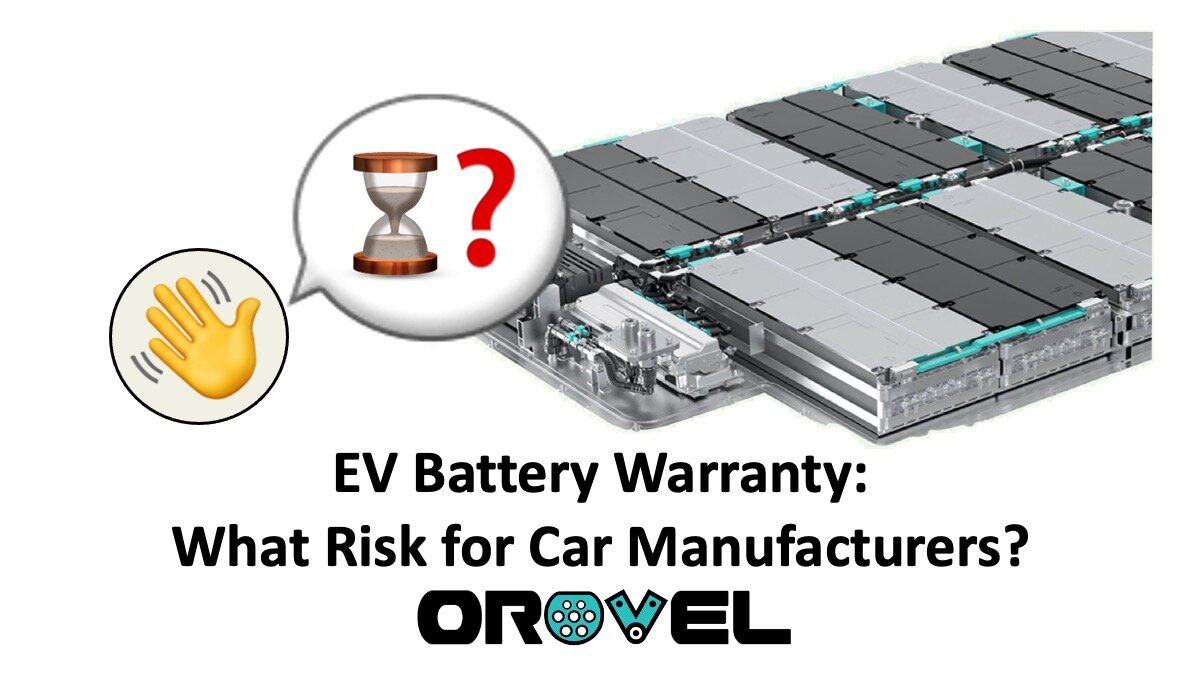EV Battery Warranty: What Risk for Car Manufacturers?
This article is a summary of a ClubHouse discussion organised on May 12th 2021. List of the Speakers at the end…
➡️ So far, Lithium Battery is part of a Vehicle and is not considered as a consumable. Therefore, it must last the whole Vehicle life, both from consumer perspective and from homologation point of view. In Europe, homologation is vehicle-based and requires the vehicle to keep the same behaviour over 5 years / 160,000 km, independently of the propulsion mode (ICE or EV).
➡️ Most Car Manufacturers (OEMs) propose a Battery Warranty of 5 - 8 years and 160,000 km (Jaguar iPace, AUDI etron, BMW, Chevy, etc.), even if Battery technologies are not designed to be measured in km or years but rather in number of cycles. It is not clear what the warranty conditions are. For example, in some cases (Toyota), the warranty applies only to the 1st owner of the vehicle. Resale does not transfer the warranty to the new owner, but usually the car dealer in charge of the resale supports a new warranty. Will it be the case for EVs? This will probably depend on observed EV reliability over the next few years…
➡️ Battery is the most expensive element of an EV (about 20% of the price). To maintain their performance, Batteries need to work within given conditions (charging/discharging voltage, temperature, timing, etc.). Any usage out of these boundaries reduce Battery life.
➡️ The 1st problem is the definition / understanding of “Battery Warranty”. Does that only include Battery operability or does that include a legal definition of performance? How do you define “performance”? Vehicle mileage, charging duration, or vehicle electric consumption? Most OEMs consider a remaining capacity of 70-80% of the initial Battery capacity as acceptable. Probably some legislation needs to be put in place or at least it must be clear for EV drivers.
➡️ OEMs keep a security in the Battery usage as the BMS limits the charge/discharge (in terms of SOC). The advantage is to protect the SOH at the expense of Battery capacity, resulting in a larger Battery pack (= more expensive, heavier for the vehicle and more CO2 to produce compared to its GHG saving objective). OEMs also guarantee themselves a contingency: if the Vehicle mileage drops too much, a software update can reallocate later a part of this “hidden capacity” to recover the initial claim.
➡️ Battery manufacturers develop chemistries to be as stable as possible. LFP offers a very good cyclability. Nevertheless, the Battery global performance also depends on a lot of other elements such as the electronics, the BMS, the Battery global architecture, the fast charging management, the cooling strategy… Consequently, the warranty responsibility cannot be support by Battery cell manufacturers.
➡️ As the health of the Battery depends on the way it is used, it is necessary to track Battery usage conditions (temperature, voltage…). As there is no legislation or standard log file formats and/or obligation to be shared, this information cannot be used for common development understanding such as Battery Fire litigation (see Hyundai KONA) or for potential 2nd life in stationary applications. Because they have been developing EV technologies for so long, but also because they are a Tech companies, Tesla has here an advantage. Their software, data collection and management offer Tesla a certain advantage in Battery management ➡️ lifecycle.
➡️ Upcoming Euro7 will bring some complication for OEMs. As Vehicle homologation will extend the same behaviour policy up to 15 years and 240,000km whatever its powertrain, this might bring additional constraint for Battery manufacturers and OEMs.
➡️ As Battery ageing hugely depends on operating conditions (temperature, voltage...), it is the responsibility of car manufacturers to guarantee and to control these limits through BMS and electronic controls. Nevertheless, most of OEMs recommend to limit the number and the frequency of fast charging which is not necessary understood by EV drivers.
➡️ Opinion about Battery Warranty responsibility have diverged during the discussion. One option could be to consider the Battery as independent of the vehicle for the homologation, but does it mean it could become a consumable? Who would be responsible for it? (the OEM?) and who would support the cost of replacement? Does it mean that the business model of a changeable (Swapping) battery could be more adapted for such a business model?
➡️ Please note that all these questions are even trickier if you consider commercial vehicles that would need >million of km of warranty or a new business model in place to guarantee the truck owner some security related to the electric vehicle he would purchase.
➡️ V2G is an additional problem for Battery Warranty. First, it adds Battery usage but no mileage, breaking the usual mileage/ageing link that most users expect. Second, this puts additional “stress” on the battery with multiple charge/discharge cycles that the customer / owner does not control. In this case, who is responsible for the Battery health and warranty? Tesla is already warning against V2G and the potential loss of warranty. If the Vehicle is not used anymore for transport, in this case how to apply transportation legislation (Euro7)?
➡️ In the end, the problem of Battery Warranty creates confusion arising from mixing transport and energy business.
Thanks to the Speakers:
Dr Veronika Wright, Expert in Battery and presenter of the YouTube channel Electrified Veronika
Roland Zenn, Head of Sourcing Li Battery Cell Materials for Gigafactories of Farasis Energy

